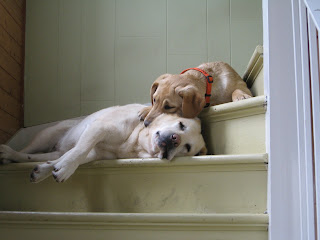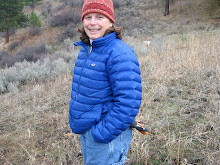
It's been over 8 months since Sage's surgery on her left knee. So far, she seems to be putting her weight on it and engaging in her "mad dogs," without much pain. But, since I started out hoping that we would be one of the 20% who wouldn't need surgery on the other knee, I have to admit I have been conservative in Sage's recovery and rehabilitation.
When I decided to proceed with the surgery I, of course, spent hours on the Internet trying to find out as much as possible about what her experience would be like, how I can make her more comfortable, the length of recovery, how to effectively rehabilitate the knee, and how to prevent a compensation injury to the other, already damaged, knee. But, amazingly, there wasn't that much practical information. What is even more amazing is that a day doesn't go by when I don't meet someone whose dog has recently had the surgery! Truly, I am beginning to believe almost every pup is going to have it....which of course makes me more than a little suspicious since several years ago I'd never heard of a dog having knee surgery. Oh well.
Some thoughts:
--Research. There are two types of knee surgery. ACL surgery, where, as my vet described it in her no nonsense way, "we just do what we learned in med school." Essentially replacing the torn ligaments with, well, fishing line! The other, much more costly surgery is Tibial Plateau Leveling Osteotomy, or TPLO. The gist of TPLO is shaving off bone to use on the knee...well you get the idea. It has a much longer recovery time however, according to canine orthopedic surgeons, it also has a greater success rate. My theory in life is if I can't understand it I don't do it. I read the TPLO information many times, had a friend read it, still didn't get it. I trusted my vet and went with that. My research boiled down to talking with the vet tech who knows me, knows my dogs, and I trust her. Simple.
--The best advice I got was to "stay ahead of the pain." When we left the vets, we left with three prescriptions. An anti-biotic, Rimadyl (a non-steroidal anti-inflamatory), and tramadol, a non-narcotic pain medication. My vet will cringe when I say this, but I loaded Sage up on the tramadol. I kept her on it for at least three months. She is still on the Rimadyl, which I think really helps. My vet prescribed 100 milligrams of Rimadyl twice a day. Sage is a big girl, around 80 pounds the day of surgery, and I think that amount of anti-inflamatory along with liberal doses of the tramadol really helped. We've now reduced the milligram amount of Rimadyl (75 mg) which most days she gets twice.
--Be conservative. The vet will tell you to only walk on leash around the yard for the first few days, then gradually walk outside that parameter. I held Sage back for well over two weeks. Then we only walked to the end of the alley, which might be 100 feet. Then to a telephone pole, then the next pole. I didn't let her walk any distance until probably two months after the surgery.
--Weight. Yeah, this one is hard. Like any orthopedic injury, weight is an issue. We're struggling with that here, still. But it's important.
--Comfort. Sage got a new, stuffed toy just for her. I slept with her the first night. I did everything I could to help her feel special. It helped that her surgery was in the middle of summer, so the weather was nice enough to let her nap outside, which she loves. By the second day she was herself, begging for chews, trying to follow me all over the house.
--Attitude. I ran into a woman several days ago who said her black lab wasn't the same after the surgery. Ouch. Sage, amazing Sage, took it all in stride. I want to think it's because we made an effort to stay ahead of the pain, not letting her feel too much hurt. And I was attentive to her. Take care of yourself, also. Ironically, I tweaked my left knee trying to help her up the back stairs. It took me several months to get back to normal, also!
--Prognosis. Hard to tell at this point. I think the knee is good, but not perfect. She occasionally limps if she's been on it for a long time. Amazingly, she is careful, herself. She doesn't go upstairs as often, rarely leaps on my bed, and hangs back when other dogs want to rough house or play too hard. Maybe she doesn't want to go through it again?
In the end, I am glad we had the surgery, grateful that I went to a doctor who I continue to see, who I trust, and believe has Sage's best interests at heart. I was worried that bringing Annie on board would be hard for Sage, given the traumatic year she'd had, but she seems to be careful on the knee, even when tempted to smack down Annie. Now, I watch Annie's knees like a hawk.
Murphy's day.
 Ok, well, Annie has been with us a little bit more than 100 days, but we thought we'd indulge in the 100 day hoopla!
Ok, well, Annie has been with us a little bit more than 100 days, but we thought we'd indulge in the 100 day hoopla!





















